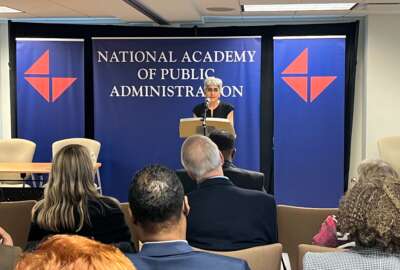
Hubbard Radio Washington DC, LLC. All rights reserved. This website is not intended for users located within the European Economic Area.
Hubbard Radio Washington DC, LLC. All rights reserved. This website is not intended for users located within the European Economic Area.
Agencies’ ‘future of work’ plans, priorities in the President’s Management Agenda and hiring reform efforts defined 2022 for federal employees.
For the federal workforce, many have described 2022 as an “inflection point.”
Agencies are at a pivotal stage of long-term changes and big decisions ahead, both looking back at how the COVID-19 pandemic changed the federal workplace, while also looking forward at what that will mean for federal employees in the future.
Federal employees saw plenty of change during 2022, as many agencies were determining what their own “future of work” would look like, whether that meant returning to the office, adding more telework opportunities, implementing hybrid work schedules — or some sort of combination.
And as agencies grappled with how to move forward from full-scale telework during the COVID-19 pandemic, many employees voiced their desire for agencies to more permanently install those types of flexibilities. According to multiple surveys, including a couple that Federal News Network conducted, a significant majority of feds were more satisfied working from home, and would be concerned if their agency increased their in-office work policies.
At the same time, the Office of Personnel Management warned that federal employees would favor agencies that offered more telework flexibilities. Agencies that enforce stricter in-person policies are more often seeing their employees head for the door, OPM said.
“What we are seeing is agency-hopping, based on where employees see the level of flexibility. We don’t have agencies having to compete with each other for different employees within the federal government,” OPM Director Kiran Ahuja said in July testimony.
Federal unions also promoted the addition of more telework opportunities at agencies, wherever possible, and pushed back on a couple of agencies for their return-to-office decisions.
For one, AFGE lauded the National Science Foundation for creating a more robust telework policy in its union contract. But others, like the Social Security Administration and the Equal Employment Opportunity Commission, drew concerns from AFGE over return-to-office implementation.
The changes in agencies’ “future of work” decisions come at a crucial time, as the federal workforce continues to age. OMB reported that about 15% of the federal workforce is currently eligible to retire, and 30% will be eligible for retirement in the next five years. At the same time, just 7% of the federal workforce is under age 30.
Many feds, even across different age groups and generations, are looking for more job flexibility and better work-life balance. It’s something agencies will likely have to grapple even more in the next couple of years.
Beyond changes to agencies’ “future of work” decisions, December also marked a year into the Biden administration’s President’s Management Agenda, the first priority of which is strengthening and empowering the federal workforce.
“It was very intentional that we decided to make strengthening and empowering the federal workforce the first of our PMA priority areas,” Office of Management and Budget Deputy Director of Management Jason Miller said at a PMA event on Dec. 13. “It’s central to everything that we’re doing across the administration and essential to the other parts of the PMA.”
The PMA’s first pillar underscores what the Biden administration has laid out to accomplish: making the federal workforce a top priority. In some cases, the focus has come through a step at a time, such as Biden publicly recognizing the 2021 Presidential Rank Awards winners, becoming the first president to do it in close to 20 years.
OMB also pointed to some progress in that first priority area of the PMA over the last year – things like standing up the first-ever Chief Diversity Officers Executive Council and establishing an employee engagement working group.
But agencies still have a lot of work ahead to look at more data on employee engagement and hiring managers’ satisfaction with the hiring process. OPM, along with the departments of Defense and Labor, also tasked agencies with defining hiring and staffing targets for mission-critical occupations. Agencies should use the data to help guide and make decisions for their workforce, leaders at OPM, DoD and Labor said.
Trying to renew focus on the federal workforce may come into play in some longer-term ways as well. Reforming the hiring process, for instance, is an ongoing concern for the federal workforce, with conversations coming from all directions – Congress, agencies and the White House.
In one hiring reform effort, the Office of Personnel Management issued skills-based hiring guidance, encouraging agencies to more highly consider candidates’ skills, rather than where they learned them. And the agency plans to expand out some pilot programs for expedited hiring used for the Infrastructure Investment and Jobs Act, while also aiming to double hiring numbers under the law during 2023.
OPM put particular focus on early-career hiring this year as well, something that has become a more pressing issue over time for the federal workforce. The Biden administration said it intends to hire 35,000 federal interns in 2023. And OPM plans to soon release guidance to agencies on paid internship opportunities.
But ultimately, these reforms to the federal hiring process will likely continue to come as bite-sized changes.
“There are folks who have talked about wholesale civil service reform, but I won’t hold my breath for that,” OPM Director Kiran Ahuja said in November.
In addition to 2022 efforts for changing federal recruitment, federal employees saw changes in another major area: the Thrift Savings Plan.
The Federal Retirement Thrift Investment Board intended the update to the online TSP platform to provide more self-service, digital options for TSP participants, but the launch gained pushback after many participants had initial issues setting up new accounts, and waiting for hours to get help from a customer service representative.
By now, many of those early issues have subsided, but some are still frustrated with the long-term, structural changes to the My Account platform. The Government Accountability Office started working on a report looking into the challenges with the TSP modernization rollout in November. When that report comes out, it may yield more answers about those early problems.
In a separate workforce area, after restoring quorum in 2022 following five years without it, the Merit Systems Protection Board is now chipping away at a massive case backlog. It’ll take years to fully remove the backlog, but MSPB said there’s been some progress. The agency can also now once again start issuing reports on federal workforce topics.
Finally, one already-overturned policy continued to hold attention this year, with debates persisting around the Schedule F executive order from the Trump administration.
Despite Biden revoking the EO at the beginning of 2021, concerns around the controversial Schedule F policy still persisted. While some Republicans hailed the EO, which would have reclassified tens of thousands of federal employees outside merit system principles, the order gained pushback from federal unions, advocacy groups and many Democrats in Congress.
Efforts to pass the Preventing a Patronage System Act legislation intended to prevent Schedule F in the future, were unsuccessful, but members of Congress have said they’ll continue working on similar priorities during 2023.
Many agencies made decisions throughout the year on federal workplace policies, but with a lot of negotiations opening up in union contracts in the next couple of months, federal employees may see even further conversations and questions ahead around the “future of work.”
Ultimately, the Biden administration has named the federal workforce as a top priority, but many of the work to demonstrate that may still lie ahead. The administration has mapped out several plans to reform federal hiring and work flexibilities, while also calling for reforms to the federal pay system.
Some of the foundation is there for larger reforms, and 2023 may be about waiting to see what gets built on top of it.
Copyright © 2024 Federal News Network. All rights reserved. This website is not intended for users located within the European Economic Area.
Drew Friedman is a workforce, pay and benefits reporter for Federal News Network.
Follow @dfriedmanWFED

